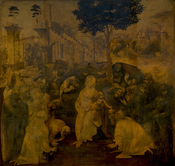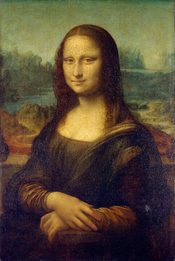Balance
Balance refers to the distribution of visual weight in a work of art. In painting, it is the visual equilibrium of the elements that causes the total image to appear balanced. Balance can be symmetrical (also referred to as "formal"), and asymmetrical balance (also called "informal balance"). Balance is usually a desirable characteristic of a composition. However, deliberately throwing off the balance of a piece in order to call more attention to some aspect of an image is, at times, desirable. For this reason, it is also necessary to discuss the concept of imbalance.
Symmetrical balance is a type of visual balance where the overall composition is arranged to look like it is the same on both sides of the center of the design. In other words, it is a design which could be folded in half, and as the design folds, each part of the design would match up with its symmetrical counterpart on the opposite side of the center.
Symmetrical balance is easiest to see in perfectly centered compositions or those with mirror images. When elements on both sides of a central horizontal or vertical line appear to be about equal in shape, weight, value, and color, the design is in symmetrical balance. In a design with only two elements they would be almost identical or have nearly the same visual mass. Symmetrical balance produces paintings that are restful, calming, and visually stable. An excellent example of symmetrical balance is Leonardo Da Vinci's Proportion of the Human Figure Fig. 1. This rather hopeful drawing illustrates that the human body can be vertically divided down the middle and the left and the right sides will correspond. When the sides of a piece match exactly, as Da Vinci would have us believe, it is referred to as pure...


